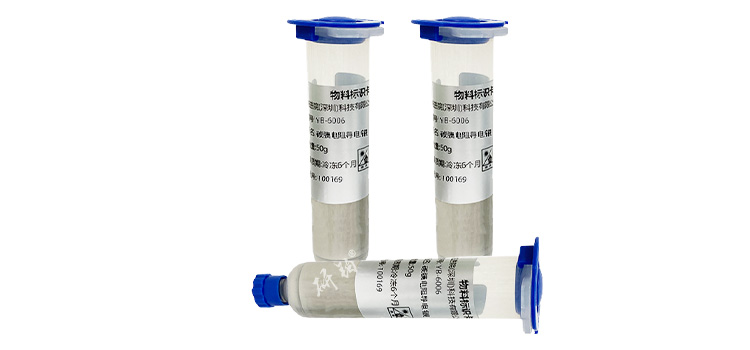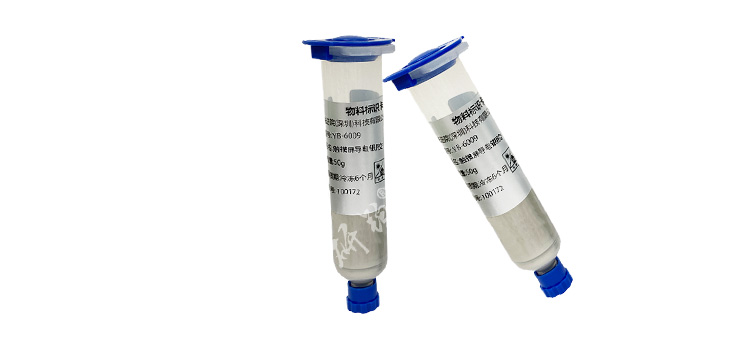

Hotline:0755-22277778
Tel:0755-22277778
Mobile:13826586185(Mr.Duan)
Fax:0755-22277776
E-mail:duanlian@xianjinyuan.cn
1. Introduction:
a.Conductive adhesiveECA consists of an insulating polymer array and conductive filler, typically silver flakes. The characteristics of this composite system can be explained by the filtering phenomenon: when a sufficient amount of conductive filler is loaded into the insulation array, the continuous interconnection between filler particles causes the system to transform from insulation material toconducting materialAs the volume ratio of conductive particles increases, the possibility of continuity also increases until the critical volume ratio is reached. Beyond this critical value, the conductivity is higher, and with further increase in volume ratio, it only slightly increases;.
b. There is a thin organic lubricating layer on the surface of the silver sheet, which is an electrically insulating material. Lovinger believes that the high initial body resistance of ECA adhesive is due to the insulating and lubricating coating on the silver sheet; The sudden appearance of conductivity during the processing is due to the insulation film being removed; The shrinkage of the epoxy array does not play a major role in both the change in conductivity and the final value of ECA;

2. Experiment:
a. Material:Advanced Institute Technology CompanyTwo types of silver flakes and one type of silver powder, with an organic lubricating layer on the surface of the silver flakes and no lubricating layer on the silver powder; A certain company has a commercial ECA product; Shell Chemical's Bisphenol F-type Epoxy Resin RSL1738; Shikoku Company's 1-cyanoethyl-2-ethyl-4-methyl (2E4MZCN); Aldrich's methanol, tetrahydrofuran THF, and diethylene-3,4-butyl ether; Ciba Geigy's three functional epoxy resin MY500; Another hardener from Aldrich, 1,2-trihydrogen and diethylethylene glycol; (Anndi: In this way, the basic formula of conductive adhesive is obvious)
b. Research methods and equipment:
Transmission Electron Microscopy (TEM) study of conductive adhesive using the JEOL-4000EX electron microscope model;
Establishment of conductivity during processing (Keithley 2000 multimeter and K-type thermocouple Omega650);
Measurement of Curling Shrinkage (Curling Shrinkage of Resin, Curling Shrinkage of Conductive Adhesive) (TA Company 2923 TMA);
■ Changes in conductivity of silver particles and conductive adhesive under external pressure (Rinck Cilwaine pressure);
Establishment of conductivity of thin silver sheets with conductive adhesion and lubrication characteristics (TA Company 2923 DSC);
Measurement of modulus changes during processing (AR1000-N);
■ Treatment of conductive adhesive (TA Company 2920 DSC);
Cross link density test (TA Company 2980 DMA);
3. Results and Discussion:
a. Observation of intra particle connections between silver flakes;
b. Establishment of conductivity of conductive adhesive during processing;
c. Research on the Relationship between Silver Lubricating Layer and Conductive Adhesive Conductivity:
Comparison of ECA conductivity between silver powder filled and lubricated silver flakes;
■Conductive adhesiveConductivity and lubrication behavior of silver flakes;
d. Research on the Relationship between Warping Shrinkage and Electrical Conductivity:
The conductivity of silver powder and ICA adhesive under external pressure;
Changes in ECA performance during dynamic processing;
Changes in ECA characteristics under isothermal conditions;
The relationship between shrinkage and conductivity

4. Conclusion:
a. When the temperature exceeds 230 degrees Celsius, the organic lubricating layer is thermally decomposed and aggregated, and the silver sheet becomes conductive. However, when the temperature is much lower than the decomposition temperature of the silver sheet, the ECA filled with silver sheet has high conductivity. Therefore, the polymer array of ECA plays a very important role in the conductivity of ECA;
b. The ECA filled with empty silver particles also exhibits high initial impedance. During the heating process, when the temperature is higher than a specific temperature, the impedance also decreases significantly. Moreover, when there is a lubricating layer on the surface of the silver sheet, the ECA adhesive can still achieve high conductivity. These results indicate that the initial state relationship between the organic lubricating layer and the conductivity of the ECA is not very significant;
c. For silver flakes with a lubricating layer and silver powders without a lubricating layer, under the premise of applying very little external pressure, the silver particles in them are tightly squeezed, resulting in high conductivity. As the pressure further increases, the corresponding impedance does not change significantly. The results show that pressure can cause conductivity in ECA;
d. During the dynamic heating process, ECA undergoes curling and shrinkage within the same temperature range, and has high electrical conductivity. Similarly, during isothermal treatment, ECA undergoes curling, shrinkage, and has high electrical conductivity within the same time range. Therefore, in both cases, when the resin curls and shrinks, the conductivity of ECA becomes very high. The results clearly indicate that the shrinkage and curling of the resin is a factor that triggers electrical conductivity during processing. ECA with higher shrinkage corresponds to lower impedance and higher conductivity. Therefore, another method to improve ECA conductivity is to increase the curling shrinkage rate of the resin by introducing multifunctional epoxy resin.


Advanced Institute (Shenzhen) Technology Co., Ltd, © two thousand and twenty-onewww.avanzado.cn. All rights reservedGuangdong ICP No. 2021051947-1 © two thousand and twenty-onewww.xianjinyuan.cn. All rights reservedGuangdong ICP No. 2021051947-2